Nursing Assignment: Cultural Sensitivity, Competency in Healthcare
VerifiedAdded on 2020/03/04
|11
|2138
|46
Report
AI Summary
This nursing assignment explores cultural sensitivity and competency within healthcare settings, focusing on the impact of cultural paradoxes, social myths, and the importance of peer support on women's health beliefs and healthcare access. The report critically evaluates the effects of inadequate competency, lack of training, and skills on patient safety, addressing the challenges of multidisciplinary approaches and communication. It examines how cultural practices, spiritual inclinations, and economic instability affect women's health and the role of peer support in overcoming social obstacles. The conclusion highlights the strengths of the literature in promoting person-centered care and identifies weaknesses, gaps, and future implications for addressing cultural biases and gender-related health disparities. The assignment includes research questions related to each theme and sub-theme to guide the analysis.
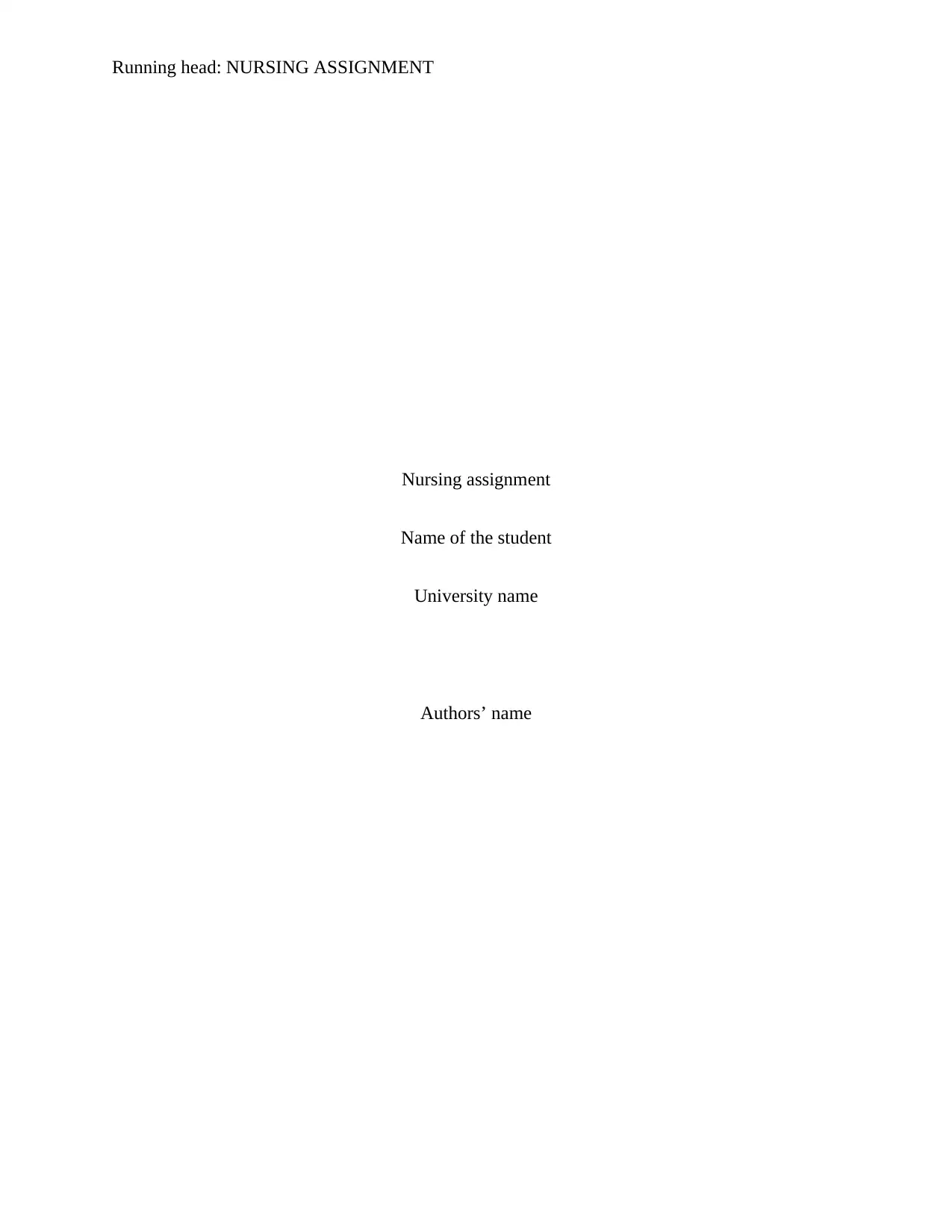
Running head: NURSING ASSIGNMENT
Nursing assignment
Name of the student
University name
Authors’ name
Nursing assignment
Name of the student
University name
Authors’ name
Paraphrase This Document
Need a fresh take? Get an instant paraphrase of this document with our AI Paraphraser
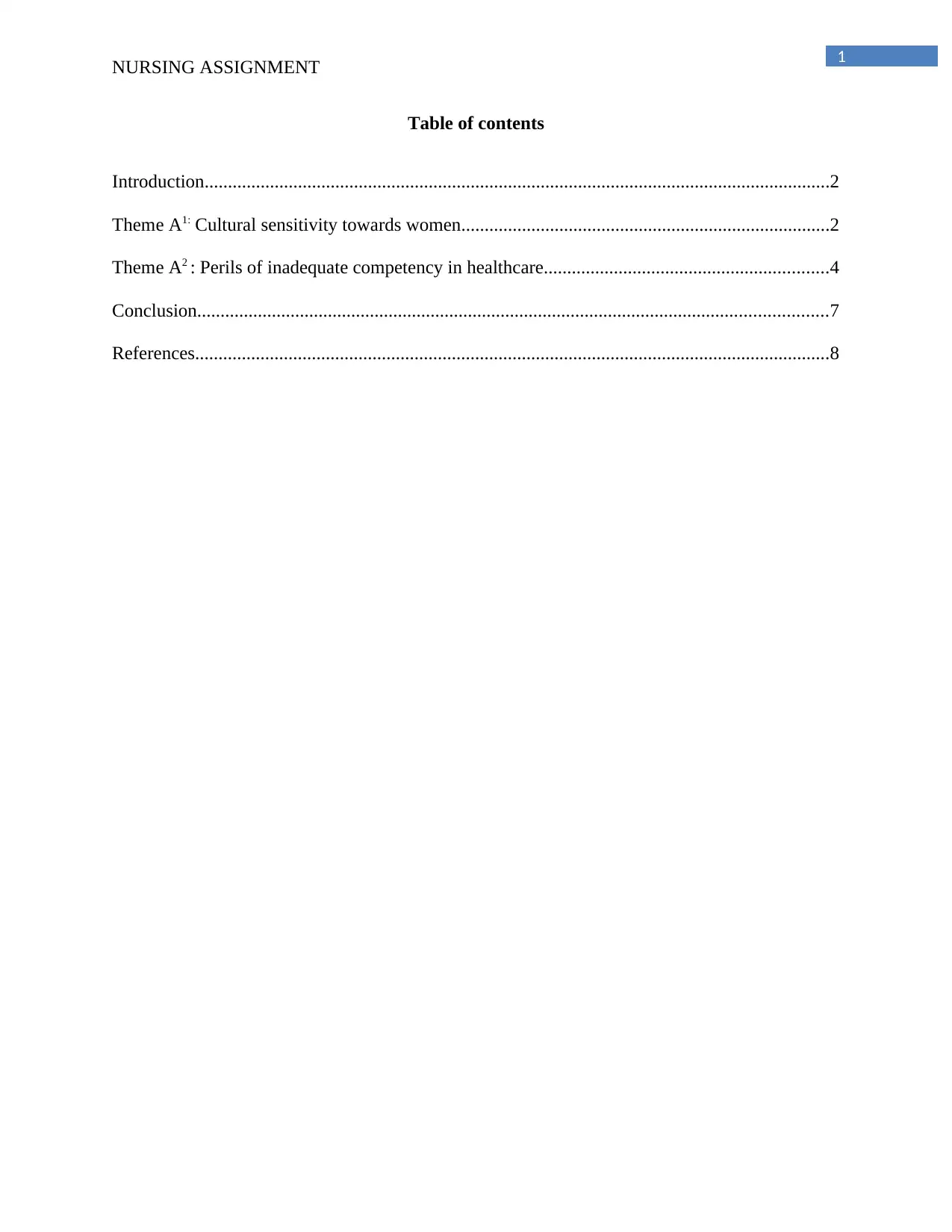
1
NURSING ASSIGNMENT
Table of contents
Introduction......................................................................................................................................2
Theme A1: Cultural sensitivity towards women...............................................................................2
Theme A2 : Perils of inadequate competency in healthcare.............................................................4
Conclusion.......................................................................................................................................7
References........................................................................................................................................8
NURSING ASSIGNMENT
Table of contents
Introduction......................................................................................................................................2
Theme A1: Cultural sensitivity towards women...............................................................................2
Theme A2 : Perils of inadequate competency in healthcare.............................................................4
Conclusion.......................................................................................................................................7
References........................................................................................................................................8
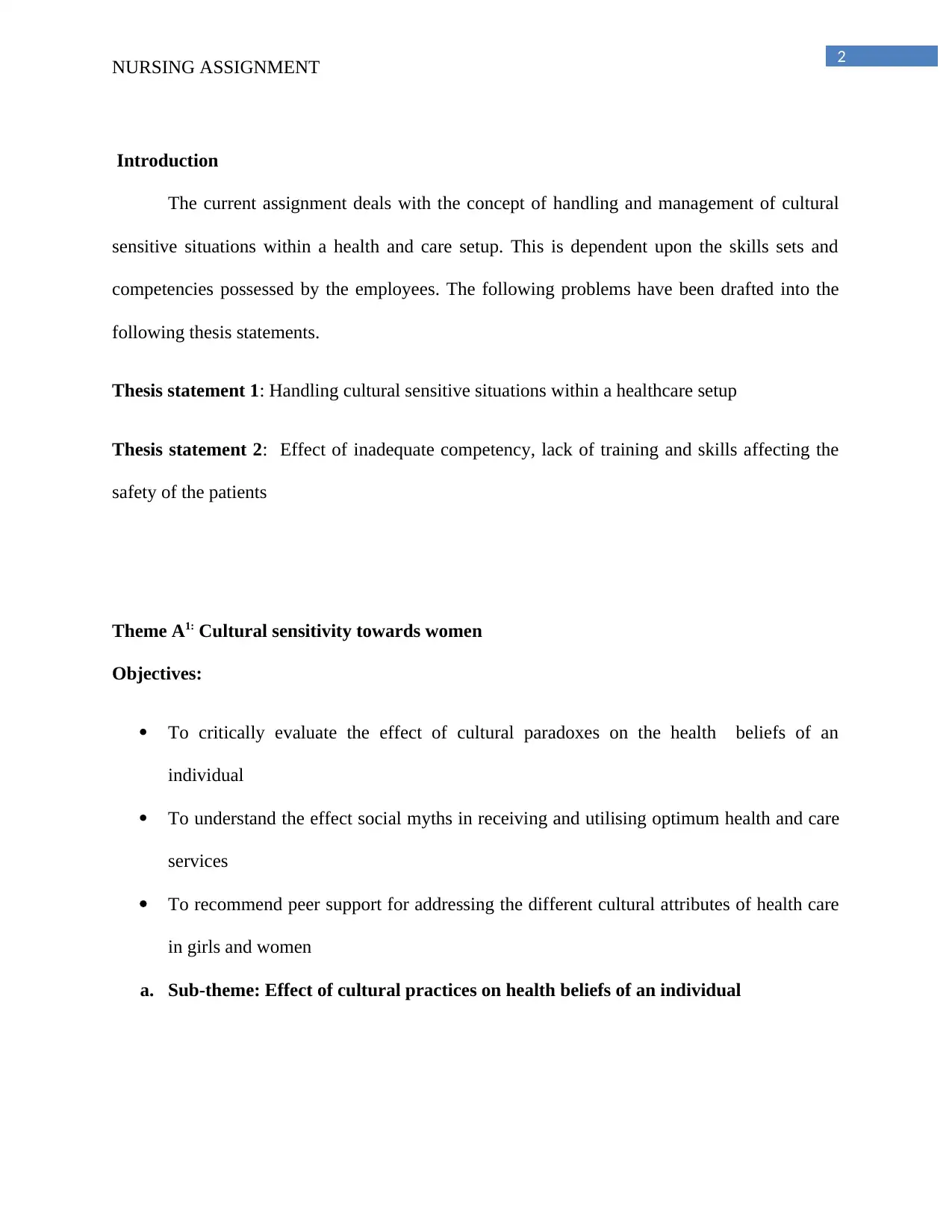
2
NURSING ASSIGNMENT
Introduction
The current assignment deals with the concept of handling and management of cultural
sensitive situations within a health and care setup. This is dependent upon the skills sets and
competencies possessed by the employees. The following problems have been drafted into the
following thesis statements.
Thesis statement 1: Handling cultural sensitive situations within a healthcare setup
Thesis statement 2: Effect of inadequate competency, lack of training and skills affecting the
safety of the patients
Theme A1: Cultural sensitivity towards women
Objectives:
To critically evaluate the effect of cultural paradoxes on the health beliefs of an
individual
To understand the effect social myths in receiving and utilising optimum health and care
services
To recommend peer support for addressing the different cultural attributes of health care
in girls and women
a. Sub-theme: Effect of cultural practices on health beliefs of an individual
NURSING ASSIGNMENT
Introduction
The current assignment deals with the concept of handling and management of cultural
sensitive situations within a health and care setup. This is dependent upon the skills sets and
competencies possessed by the employees. The following problems have been drafted into the
following thesis statements.
Thesis statement 1: Handling cultural sensitive situations within a healthcare setup
Thesis statement 2: Effect of inadequate competency, lack of training and skills affecting the
safety of the patients
Theme A1: Cultural sensitivity towards women
Objectives:
To critically evaluate the effect of cultural paradoxes on the health beliefs of an
individual
To understand the effect social myths in receiving and utilising optimum health and care
services
To recommend peer support for addressing the different cultural attributes of health care
in girls and women
a. Sub-theme: Effect of cultural practices on health beliefs of an individual
⊘ This is a preview!⊘
Do you want full access?
Subscribe today to unlock all pages.

Trusted by 1+ million students worldwide
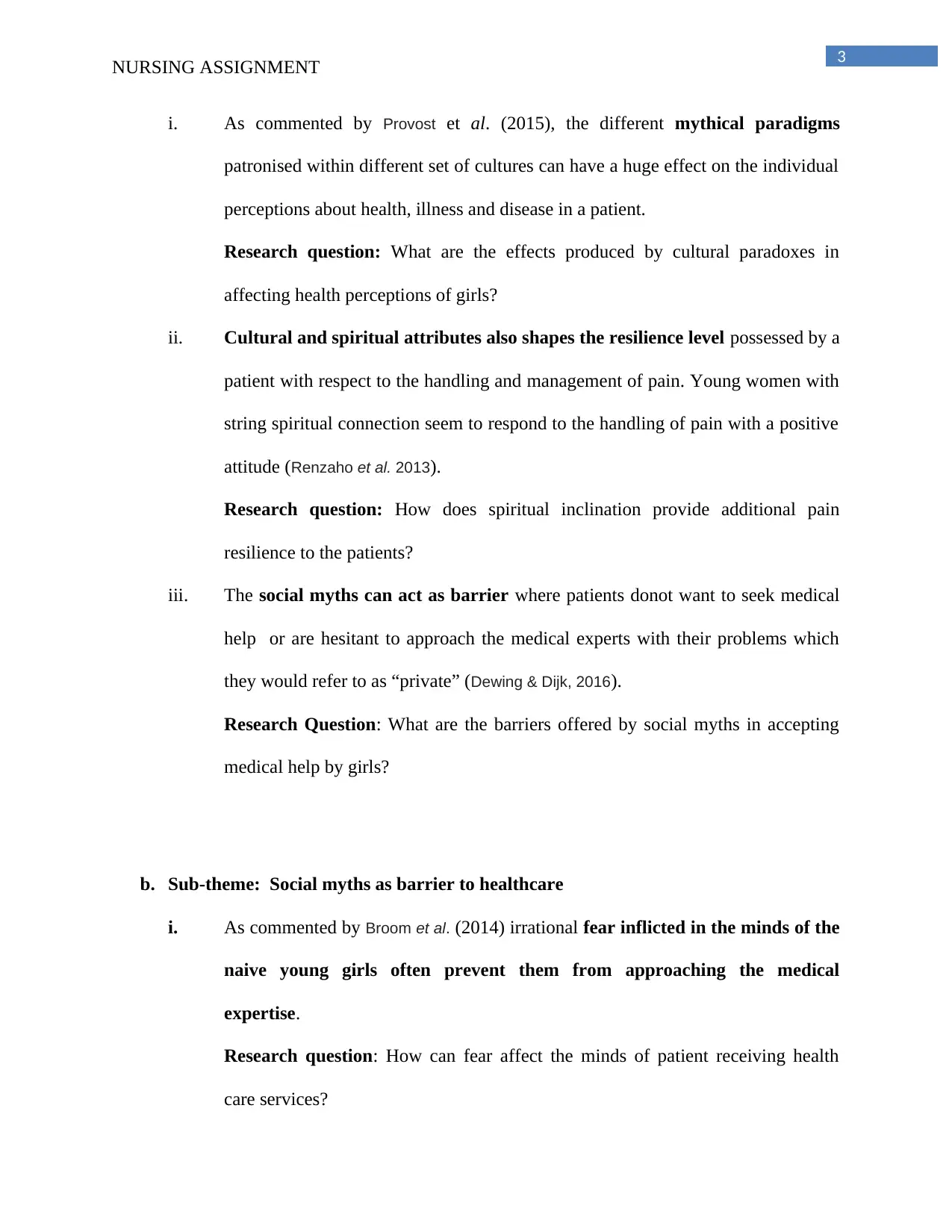
3
NURSING ASSIGNMENT
i. As commented by Provost et al. (2015), the different mythical paradigms
patronised within different set of cultures can have a huge effect on the individual
perceptions about health, illness and disease in a patient.
Research question: What are the effects produced by cultural paradoxes in
affecting health perceptions of girls?
ii. Cultural and spiritual attributes also shapes the resilience level possessed by a
patient with respect to the handling and management of pain. Young women with
string spiritual connection seem to respond to the handling of pain with a positive
attitude (Renzaho et al. 2013).
Research question: How does spiritual inclination provide additional pain
resilience to the patients?
iii. The social myths can act as barrier where patients donot want to seek medical
help or are hesitant to approach the medical experts with their problems which
they would refer to as “private” (Dewing & Dijk, 2016).
Research Question: What are the barriers offered by social myths in accepting
medical help by girls?
b. Sub-theme: Social myths as barrier to healthcare
i. As commented by Broom et al. (2014) irrational fear inflicted in the minds of the
naive young girls often prevent them from approaching the medical
expertise.
Research question: How can fear affect the minds of patient receiving health
care services?
NURSING ASSIGNMENT
i. As commented by Provost et al. (2015), the different mythical paradigms
patronised within different set of cultures can have a huge effect on the individual
perceptions about health, illness and disease in a patient.
Research question: What are the effects produced by cultural paradoxes in
affecting health perceptions of girls?
ii. Cultural and spiritual attributes also shapes the resilience level possessed by a
patient with respect to the handling and management of pain. Young women with
string spiritual connection seem to respond to the handling of pain with a positive
attitude (Renzaho et al. 2013).
Research question: How does spiritual inclination provide additional pain
resilience to the patients?
iii. The social myths can act as barrier where patients donot want to seek medical
help or are hesitant to approach the medical experts with their problems which
they would refer to as “private” (Dewing & Dijk, 2016).
Research Question: What are the barriers offered by social myths in accepting
medical help by girls?
b. Sub-theme: Social myths as barrier to healthcare
i. As commented by Broom et al. (2014) irrational fear inflicted in the minds of the
naive young girls often prevent them from approaching the medical
expertise.
Research question: How can fear affect the minds of patient receiving health
care services?
Paraphrase This Document
Need a fresh take? Get an instant paraphrase of this document with our AI Paraphraser
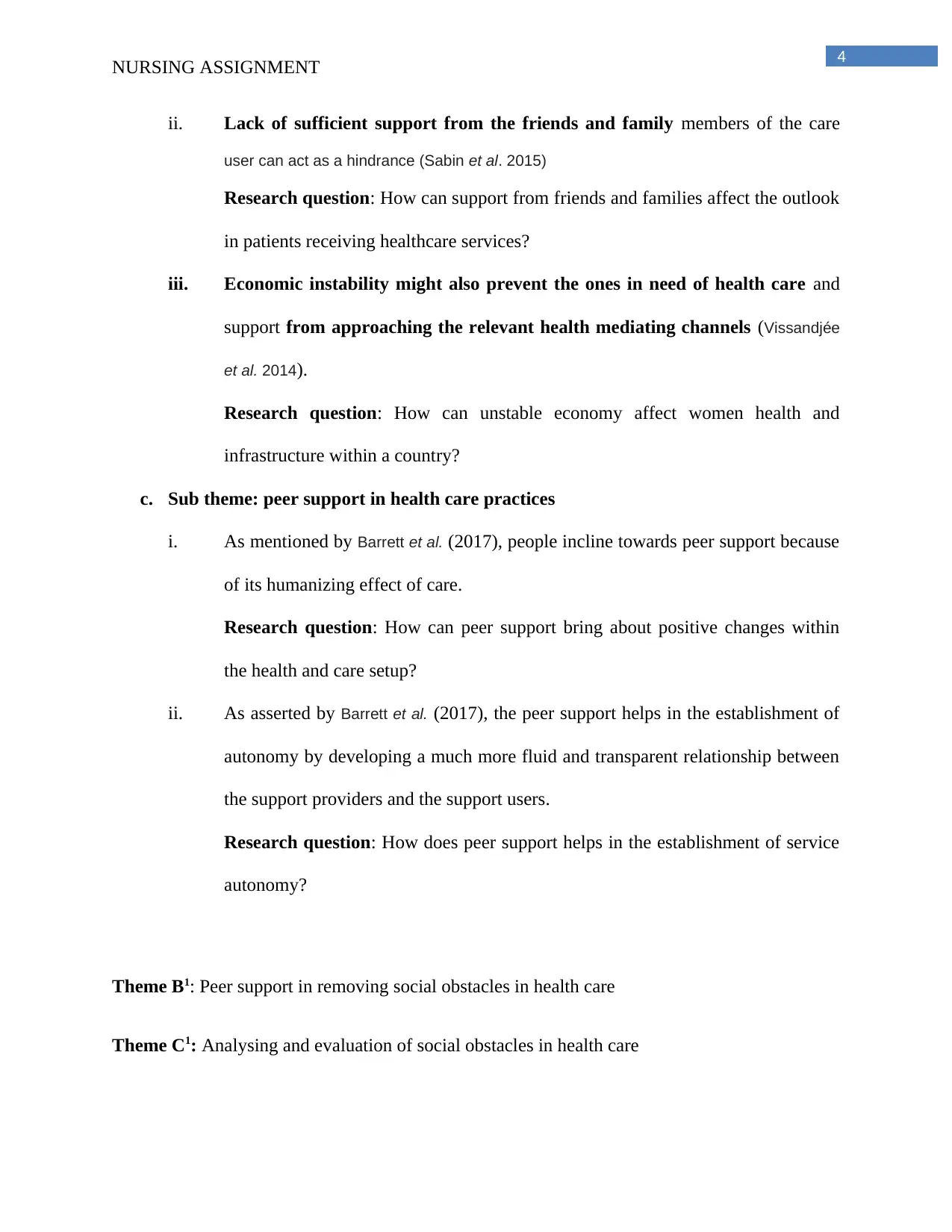
4
NURSING ASSIGNMENT
ii. Lack of sufficient support from the friends and family members of the care
user can act as a hindrance (Sabin et al. 2015)
Research question: How can support from friends and families affect the outlook
in patients receiving healthcare services?
iii. Economic instability might also prevent the ones in need of health care and
support from approaching the relevant health mediating channels (Vissandjée
et al. 2014).
Research question: How can unstable economy affect women health and
infrastructure within a country?
c. Sub theme: peer support in health care practices
i. As mentioned by Barrett et al. (2017), people incline towards peer support because
of its humanizing effect of care.
Research question: How can peer support bring about positive changes within
the health and care setup?
ii. As asserted by Barrett et al. (2017), the peer support helps in the establishment of
autonomy by developing a much more fluid and transparent relationship between
the support providers and the support users.
Research question: How does peer support helps in the establishment of service
autonomy?
Theme B1: Peer support in removing social obstacles in health care
Theme C1: Analysing and evaluation of social obstacles in health care
NURSING ASSIGNMENT
ii. Lack of sufficient support from the friends and family members of the care
user can act as a hindrance (Sabin et al. 2015)
Research question: How can support from friends and families affect the outlook
in patients receiving healthcare services?
iii. Economic instability might also prevent the ones in need of health care and
support from approaching the relevant health mediating channels (Vissandjée
et al. 2014).
Research question: How can unstable economy affect women health and
infrastructure within a country?
c. Sub theme: peer support in health care practices
i. As mentioned by Barrett et al. (2017), people incline towards peer support because
of its humanizing effect of care.
Research question: How can peer support bring about positive changes within
the health and care setup?
ii. As asserted by Barrett et al. (2017), the peer support helps in the establishment of
autonomy by developing a much more fluid and transparent relationship between
the support providers and the support users.
Research question: How does peer support helps in the establishment of service
autonomy?
Theme B1: Peer support in removing social obstacles in health care
Theme C1: Analysing and evaluation of social obstacles in health care
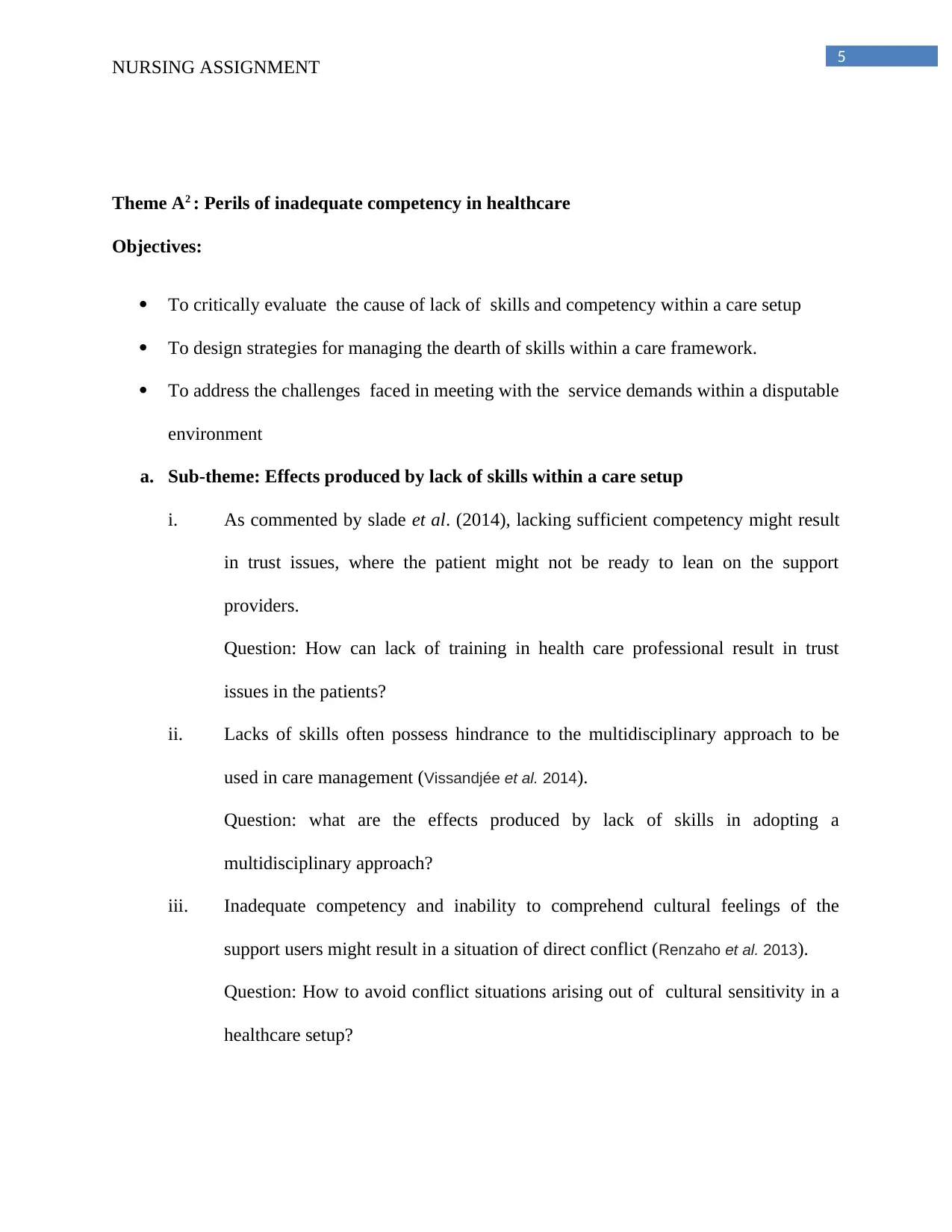
5
NURSING ASSIGNMENT
Theme A2 : Perils of inadequate competency in healthcare
Objectives:
To critically evaluate the cause of lack of skills and competency within a care setup
To design strategies for managing the dearth of skills within a care framework.
To address the challenges faced in meeting with the service demands within a disputable
environment
a. Sub-theme: Effects produced by lack of skills within a care setup
i. As commented by slade et al. (2014), lacking sufficient competency might result
in trust issues, where the patient might not be ready to lean on the support
providers.
Question: How can lack of training in health care professional result in trust
issues in the patients?
ii. Lacks of skills often possess hindrance to the multidisciplinary approach to be
used in care management (Vissandjée et al. 2014).
Question: what are the effects produced by lack of skills in adopting a
multidisciplinary approach?
iii. Inadequate competency and inability to comprehend cultural feelings of the
support users might result in a situation of direct conflict (Renzaho et al. 2013).
Question: How to avoid conflict situations arising out of cultural sensitivity in a
healthcare setup?
NURSING ASSIGNMENT
Theme A2 : Perils of inadequate competency in healthcare
Objectives:
To critically evaluate the cause of lack of skills and competency within a care setup
To design strategies for managing the dearth of skills within a care framework.
To address the challenges faced in meeting with the service demands within a disputable
environment
a. Sub-theme: Effects produced by lack of skills within a care setup
i. As commented by slade et al. (2014), lacking sufficient competency might result
in trust issues, where the patient might not be ready to lean on the support
providers.
Question: How can lack of training in health care professional result in trust
issues in the patients?
ii. Lacks of skills often possess hindrance to the multidisciplinary approach to be
used in care management (Vissandjée et al. 2014).
Question: what are the effects produced by lack of skills in adopting a
multidisciplinary approach?
iii. Inadequate competency and inability to comprehend cultural feelings of the
support users might result in a situation of direct conflict (Renzaho et al. 2013).
Question: How to avoid conflict situations arising out of cultural sensitivity in a
healthcare setup?
⊘ This is a preview!⊘
Do you want full access?
Subscribe today to unlock all pages.

Trusted by 1+ million students worldwide
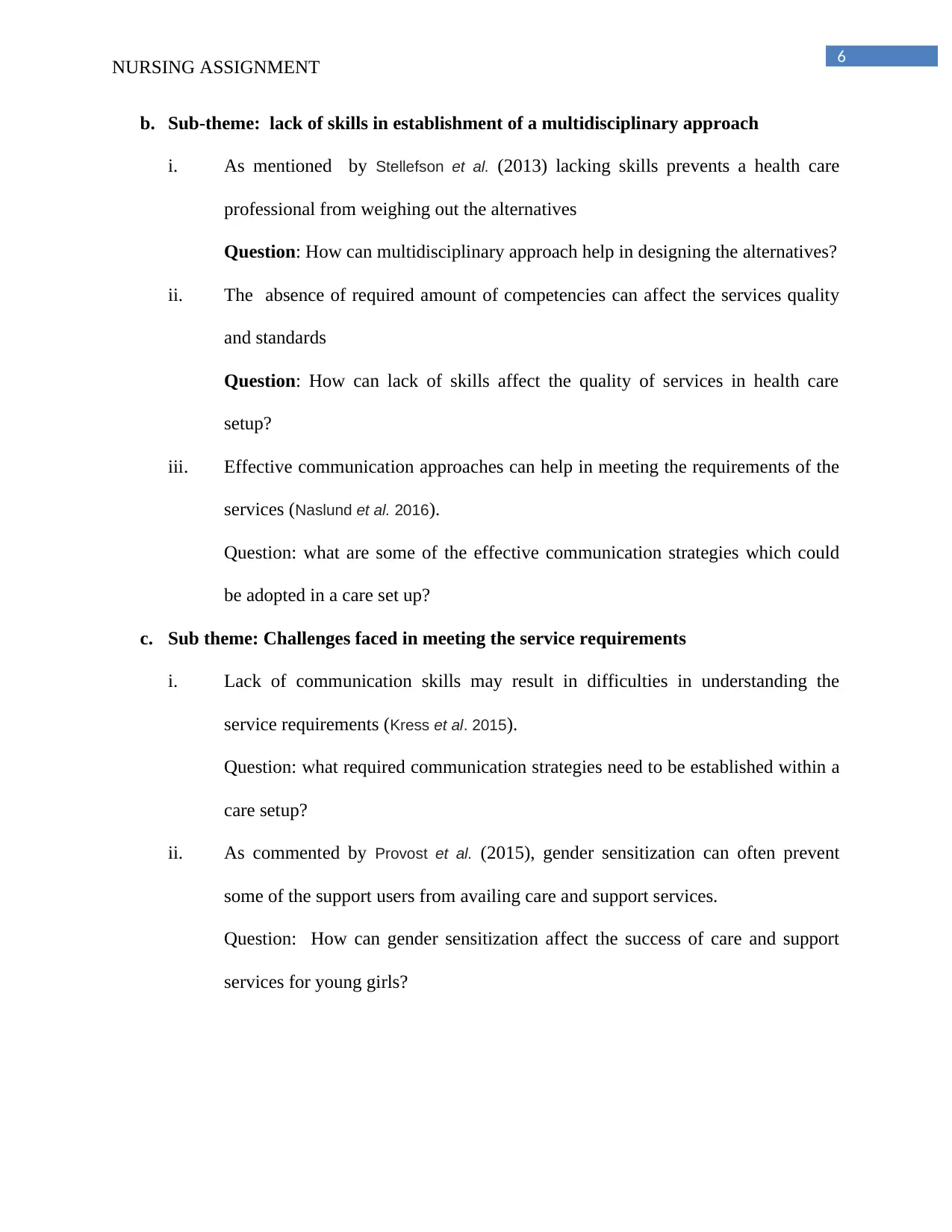
6
NURSING ASSIGNMENT
b. Sub-theme: lack of skills in establishment of a multidisciplinary approach
i. As mentioned by Stellefson et al. (2013) lacking skills prevents a health care
professional from weighing out the alternatives
Question: How can multidisciplinary approach help in designing the alternatives?
ii. The absence of required amount of competencies can affect the services quality
and standards
Question: How can lack of skills affect the quality of services in health care
setup?
iii. Effective communication approaches can help in meeting the requirements of the
services (Naslund et al. 2016).
Question: what are some of the effective communication strategies which could
be adopted in a care set up?
c. Sub theme: Challenges faced in meeting the service requirements
i. Lack of communication skills may result in difficulties in understanding the
service requirements (Kress et al. 2015).
Question: what required communication strategies need to be established within a
care setup?
ii. As commented by Provost et al. (2015), gender sensitization can often prevent
some of the support users from availing care and support services.
Question: How can gender sensitization affect the success of care and support
services for young girls?
NURSING ASSIGNMENT
b. Sub-theme: lack of skills in establishment of a multidisciplinary approach
i. As mentioned by Stellefson et al. (2013) lacking skills prevents a health care
professional from weighing out the alternatives
Question: How can multidisciplinary approach help in designing the alternatives?
ii. The absence of required amount of competencies can affect the services quality
and standards
Question: How can lack of skills affect the quality of services in health care
setup?
iii. Effective communication approaches can help in meeting the requirements of the
services (Naslund et al. 2016).
Question: what are some of the effective communication strategies which could
be adopted in a care set up?
c. Sub theme: Challenges faced in meeting the service requirements
i. Lack of communication skills may result in difficulties in understanding the
service requirements (Kress et al. 2015).
Question: what required communication strategies need to be established within a
care setup?
ii. As commented by Provost et al. (2015), gender sensitization can often prevent
some of the support users from availing care and support services.
Question: How can gender sensitization affect the success of care and support
services for young girls?
Paraphrase This Document
Need a fresh take? Get an instant paraphrase of this document with our AI Paraphraser
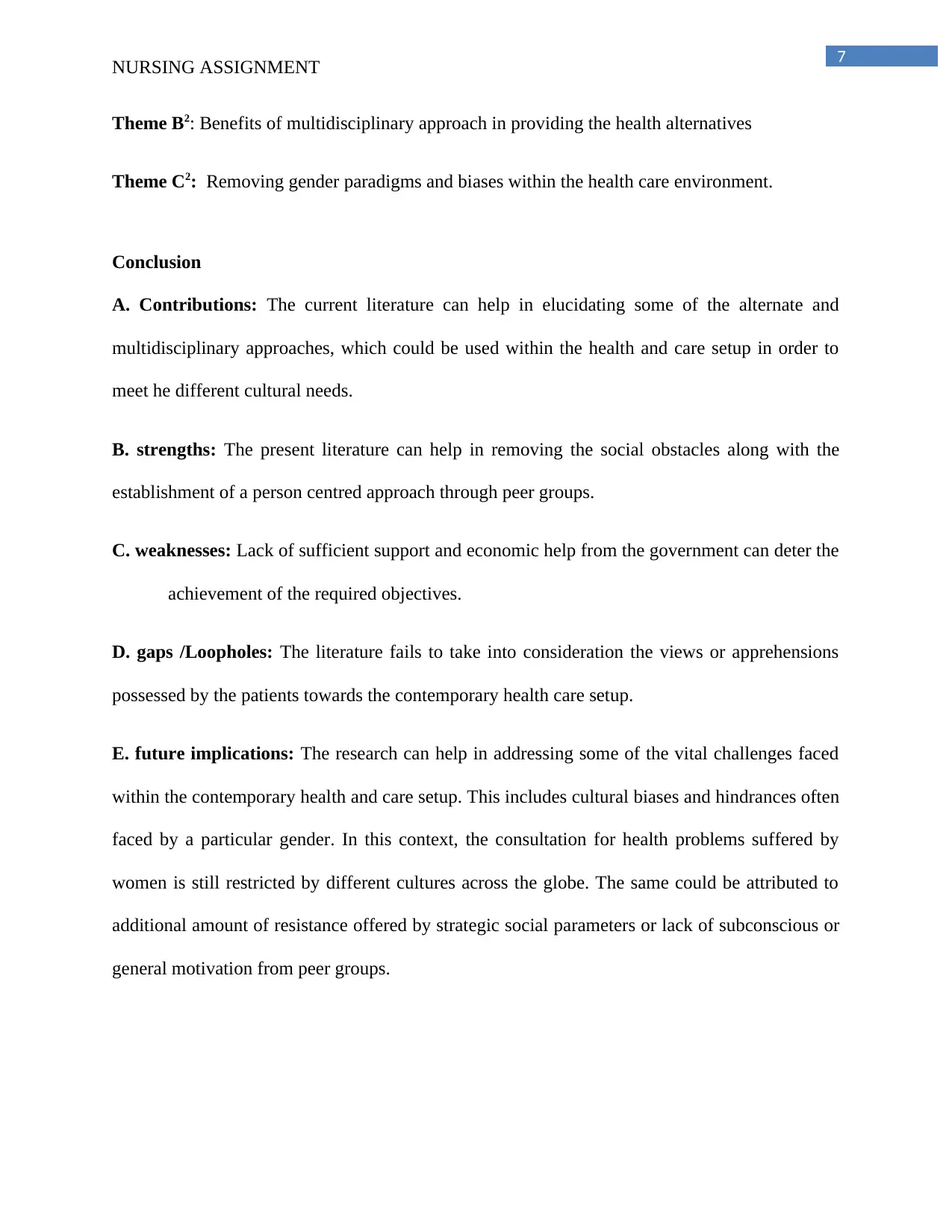
7
NURSING ASSIGNMENT
Theme B2: Benefits of multidisciplinary approach in providing the health alternatives
Theme C2: Removing gender paradigms and biases within the health care environment.
Conclusion
A. Contributions: The current literature can help in elucidating some of the alternate and
multidisciplinary approaches, which could be used within the health and care setup in order to
meet he different cultural needs.
B. strengths: The present literature can help in removing the social obstacles along with the
establishment of a person centred approach through peer groups.
C. weaknesses: Lack of sufficient support and economic help from the government can deter the
achievement of the required objectives.
D. gaps /Loopholes: The literature fails to take into consideration the views or apprehensions
possessed by the patients towards the contemporary health care setup.
E. future implications: The research can help in addressing some of the vital challenges faced
within the contemporary health and care setup. This includes cultural biases and hindrances often
faced by a particular gender. In this context, the consultation for health problems suffered by
women is still restricted by different cultures across the globe. The same could be attributed to
additional amount of resistance offered by strategic social parameters or lack of subconscious or
general motivation from peer groups.
NURSING ASSIGNMENT
Theme B2: Benefits of multidisciplinary approach in providing the health alternatives
Theme C2: Removing gender paradigms and biases within the health care environment.
Conclusion
A. Contributions: The current literature can help in elucidating some of the alternate and
multidisciplinary approaches, which could be used within the health and care setup in order to
meet he different cultural needs.
B. strengths: The present literature can help in removing the social obstacles along with the
establishment of a person centred approach through peer groups.
C. weaknesses: Lack of sufficient support and economic help from the government can deter the
achievement of the required objectives.
D. gaps /Loopholes: The literature fails to take into consideration the views or apprehensions
possessed by the patients towards the contemporary health care setup.
E. future implications: The research can help in addressing some of the vital challenges faced
within the contemporary health and care setup. This includes cultural biases and hindrances often
faced by a particular gender. In this context, the consultation for health problems suffered by
women is still restricted by different cultures across the globe. The same could be attributed to
additional amount of resistance offered by strategic social parameters or lack of subconscious or
general motivation from peer groups.
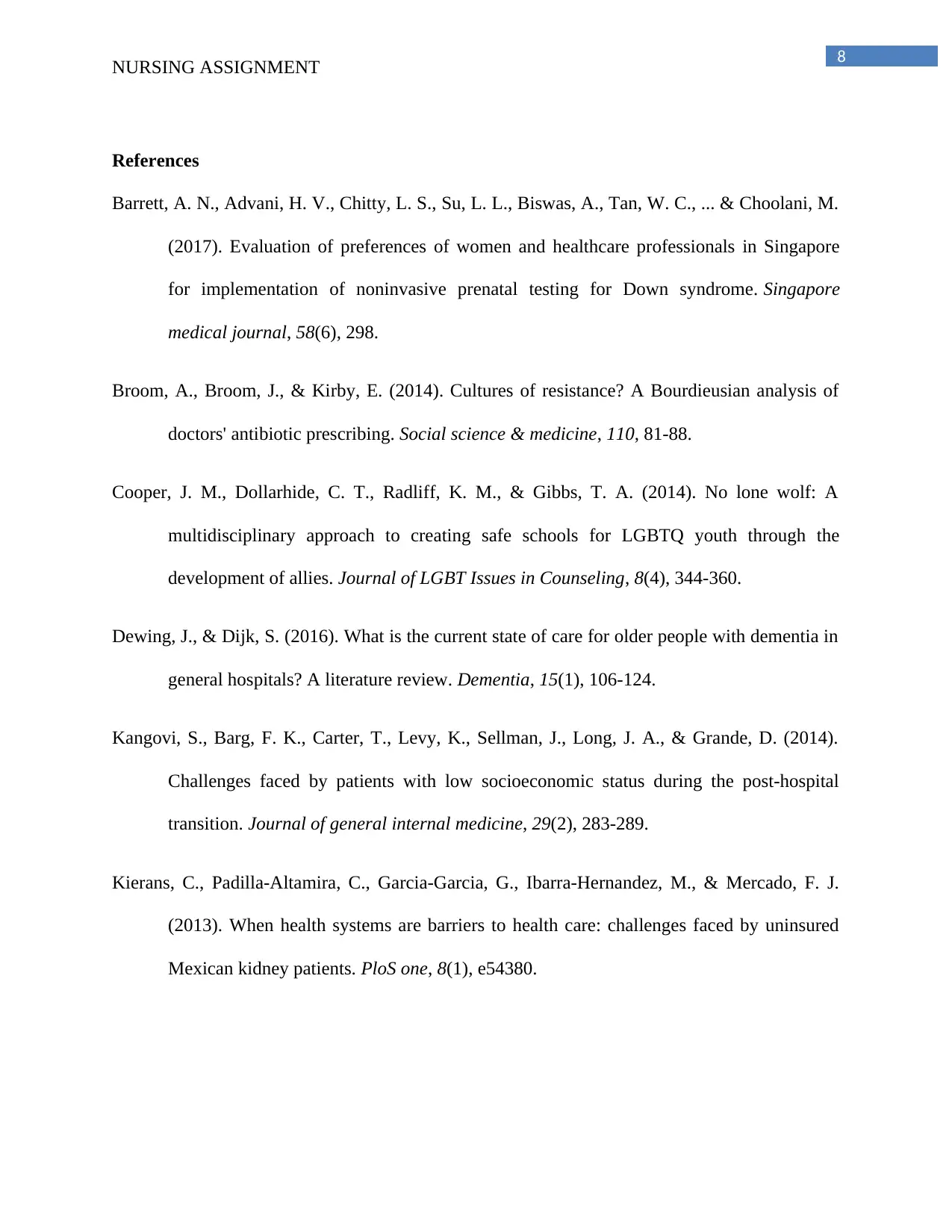
8
NURSING ASSIGNMENT
References
Barrett, A. N., Advani, H. V., Chitty, L. S., Su, L. L., Biswas, A., Tan, W. C., ... & Choolani, M.
(2017). Evaluation of preferences of women and healthcare professionals in Singapore
for implementation of noninvasive prenatal testing for Down syndrome. Singapore
medical journal, 58(6), 298.
Broom, A., Broom, J., & Kirby, E. (2014). Cultures of resistance? A Bourdieusian analysis of
doctors' antibiotic prescribing. Social science & medicine, 110, 81-88.
Cooper, J. M., Dollarhide, C. T., Radliff, K. M., & Gibbs, T. A. (2014). No lone wolf: A
multidisciplinary approach to creating safe schools for LGBTQ youth through the
development of allies. Journal of LGBT Issues in Counseling, 8(4), 344-360.
Dewing, J., & Dijk, S. (2016). What is the current state of care for older people with dementia in
general hospitals? A literature review. Dementia, 15(1), 106-124.
Kangovi, S., Barg, F. K., Carter, T., Levy, K., Sellman, J., Long, J. A., & Grande, D. (2014).
Challenges faced by patients with low socioeconomic status during the post-hospital
transition. Journal of general internal medicine, 29(2), 283-289.
Kierans, C., Padilla-Altamira, C., Garcia-Garcia, G., Ibarra-Hernandez, M., & Mercado, F. J.
(2013). When health systems are barriers to health care: challenges faced by uninsured
Mexican kidney patients. PloS one, 8(1), e54380.
NURSING ASSIGNMENT
References
Barrett, A. N., Advani, H. V., Chitty, L. S., Su, L. L., Biswas, A., Tan, W. C., ... & Choolani, M.
(2017). Evaluation of preferences of women and healthcare professionals in Singapore
for implementation of noninvasive prenatal testing for Down syndrome. Singapore
medical journal, 58(6), 298.
Broom, A., Broom, J., & Kirby, E. (2014). Cultures of resistance? A Bourdieusian analysis of
doctors' antibiotic prescribing. Social science & medicine, 110, 81-88.
Cooper, J. M., Dollarhide, C. T., Radliff, K. M., & Gibbs, T. A. (2014). No lone wolf: A
multidisciplinary approach to creating safe schools for LGBTQ youth through the
development of allies. Journal of LGBT Issues in Counseling, 8(4), 344-360.
Dewing, J., & Dijk, S. (2016). What is the current state of care for older people with dementia in
general hospitals? A literature review. Dementia, 15(1), 106-124.
Kangovi, S., Barg, F. K., Carter, T., Levy, K., Sellman, J., Long, J. A., & Grande, D. (2014).
Challenges faced by patients with low socioeconomic status during the post-hospital
transition. Journal of general internal medicine, 29(2), 283-289.
Kierans, C., Padilla-Altamira, C., Garcia-Garcia, G., Ibarra-Hernandez, M., & Mercado, F. J.
(2013). When health systems are barriers to health care: challenges faced by uninsured
Mexican kidney patients. PloS one, 8(1), e54380.
⊘ This is a preview!⊘
Do you want full access?
Subscribe today to unlock all pages.

Trusted by 1+ million students worldwide
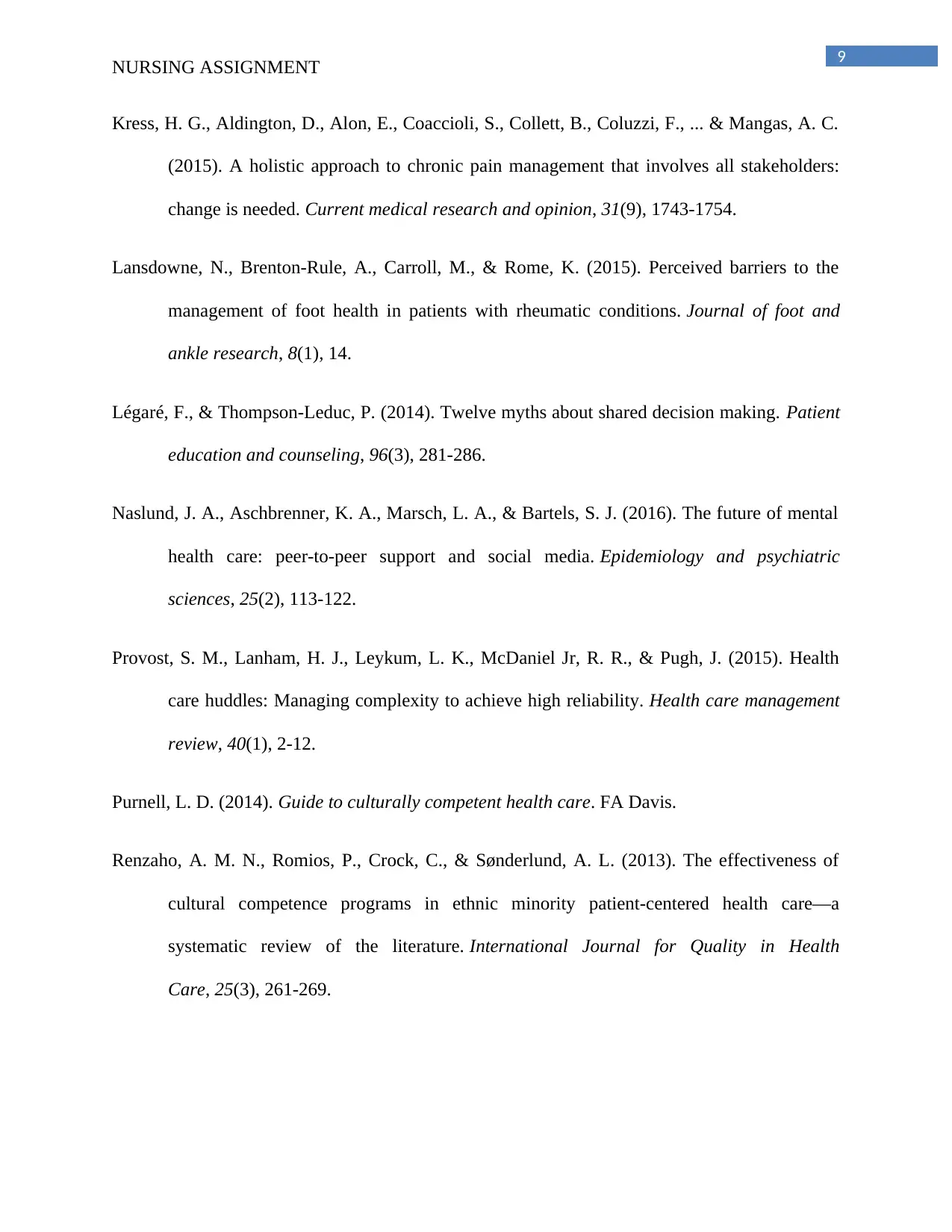
9
NURSING ASSIGNMENT
Kress, H. G., Aldington, D., Alon, E., Coaccioli, S., Collett, B., Coluzzi, F., ... & Mangas, A. C.
(2015). A holistic approach to chronic pain management that involves all stakeholders:
change is needed. Current medical research and opinion, 31(9), 1743-1754.
Lansdowne, N., Brenton-Rule, A., Carroll, M., & Rome, K. (2015). Perceived barriers to the
management of foot health in patients with rheumatic conditions. Journal of foot and
ankle research, 8(1), 14.
Légaré, F., & Thompson-Leduc, P. (2014). Twelve myths about shared decision making. Patient
education and counseling, 96(3), 281-286.
Naslund, J. A., Aschbrenner, K. A., Marsch, L. A., & Bartels, S. J. (2016). The future of mental
health care: peer-to-peer support and social media. Epidemiology and psychiatric
sciences, 25(2), 113-122.
Provost, S. M., Lanham, H. J., Leykum, L. K., McDaniel Jr, R. R., & Pugh, J. (2015). Health
care huddles: Managing complexity to achieve high reliability. Health care management
review, 40(1), 2-12.
Purnell, L. D. (2014). Guide to culturally competent health care. FA Davis.
Renzaho, A. M. N., Romios, P., Crock, C., & Sønderlund, A. L. (2013). The effectiveness of
cultural competence programs in ethnic minority patient-centered health care—a
systematic review of the literature. International Journal for Quality in Health
Care, 25(3), 261-269.
NURSING ASSIGNMENT
Kress, H. G., Aldington, D., Alon, E., Coaccioli, S., Collett, B., Coluzzi, F., ... & Mangas, A. C.
(2015). A holistic approach to chronic pain management that involves all stakeholders:
change is needed. Current medical research and opinion, 31(9), 1743-1754.
Lansdowne, N., Brenton-Rule, A., Carroll, M., & Rome, K. (2015). Perceived barriers to the
management of foot health in patients with rheumatic conditions. Journal of foot and
ankle research, 8(1), 14.
Légaré, F., & Thompson-Leduc, P. (2014). Twelve myths about shared decision making. Patient
education and counseling, 96(3), 281-286.
Naslund, J. A., Aschbrenner, K. A., Marsch, L. A., & Bartels, S. J. (2016). The future of mental
health care: peer-to-peer support and social media. Epidemiology and psychiatric
sciences, 25(2), 113-122.
Provost, S. M., Lanham, H. J., Leykum, L. K., McDaniel Jr, R. R., & Pugh, J. (2015). Health
care huddles: Managing complexity to achieve high reliability. Health care management
review, 40(1), 2-12.
Purnell, L. D. (2014). Guide to culturally competent health care. FA Davis.
Renzaho, A. M. N., Romios, P., Crock, C., & Sønderlund, A. L. (2013). The effectiveness of
cultural competence programs in ethnic minority patient-centered health care—a
systematic review of the literature. International Journal for Quality in Health
Care, 25(3), 261-269.
Paraphrase This Document
Need a fresh take? Get an instant paraphrase of this document with our AI Paraphraser
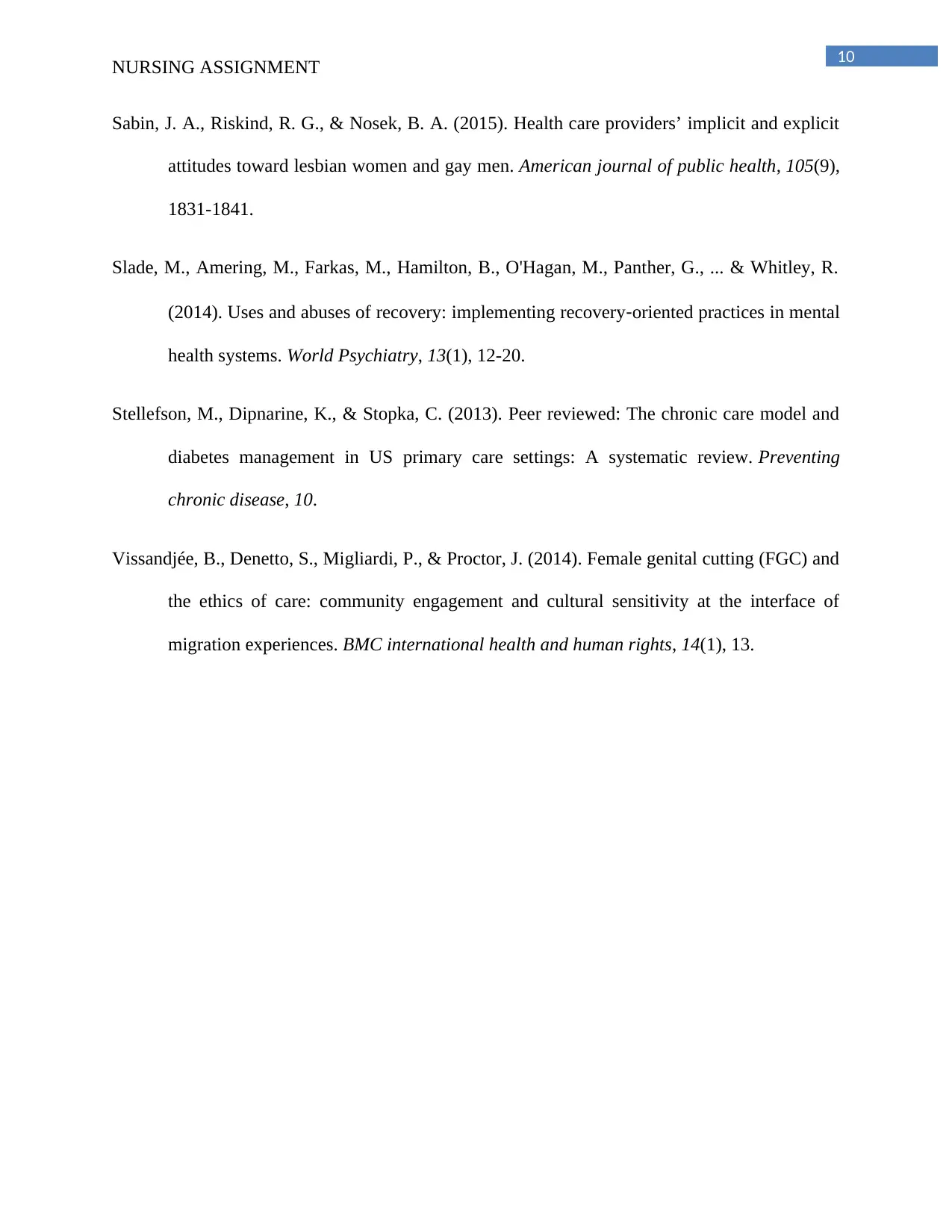
10
NURSING ASSIGNMENT
Sabin, J. A., Riskind, R. G., & Nosek, B. A. (2015). Health care providers’ implicit and explicit
attitudes toward lesbian women and gay men. American journal of public health, 105(9),
1831-1841.
Slade, M., Amering, M., Farkas, M., Hamilton, B., O'Hagan, M., Panther, G., ... & Whitley, R.
(2014). Uses and abuses of recovery: implementing recovery‐oriented practices in mental
health systems. World Psychiatry, 13(1), 12-20.
Stellefson, M., Dipnarine, K., & Stopka, C. (2013). Peer reviewed: The chronic care model and
diabetes management in US primary care settings: A systematic review. Preventing
chronic disease, 10.
Vissandjée, B., Denetto, S., Migliardi, P., & Proctor, J. (2014). Female genital cutting (FGC) and
the ethics of care: community engagement and cultural sensitivity at the interface of
migration experiences. BMC international health and human rights, 14(1), 13.
NURSING ASSIGNMENT
Sabin, J. A., Riskind, R. G., & Nosek, B. A. (2015). Health care providers’ implicit and explicit
attitudes toward lesbian women and gay men. American journal of public health, 105(9),
1831-1841.
Slade, M., Amering, M., Farkas, M., Hamilton, B., O'Hagan, M., Panther, G., ... & Whitley, R.
(2014). Uses and abuses of recovery: implementing recovery‐oriented practices in mental
health systems. World Psychiatry, 13(1), 12-20.
Stellefson, M., Dipnarine, K., & Stopka, C. (2013). Peer reviewed: The chronic care model and
diabetes management in US primary care settings: A systematic review. Preventing
chronic disease, 10.
Vissandjée, B., Denetto, S., Migliardi, P., & Proctor, J. (2014). Female genital cutting (FGC) and
the ethics of care: community engagement and cultural sensitivity at the interface of
migration experiences. BMC international health and human rights, 14(1), 13.
1 out of 11
Related Documents
Your All-in-One AI-Powered Toolkit for Academic Success.
+13062052269
info@desklib.com
Available 24*7 on WhatsApp / Email
![[object Object]](/_next/static/media/star-bottom.7253800d.svg)
Unlock your academic potential
Copyright © 2020–2025 A2Z Services. All Rights Reserved. Developed and managed by ZUCOL.





